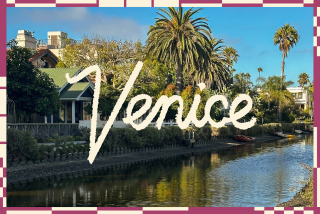Perennially Battling Rising Waters, Soggy Venice Prays for Tide of Money : Italy: There is an ambitious plan to ease the historic city’s flooding, but so far the funds haven’t been forthcoming.
- Share via
VENICE, Italy — The sirens wailed, the waters of the Adriatic Sea crept into St. Mark’s Square and a cold chill struck the memory of every Venetian who had suffered through the historic floods of 1966.
It was Nov. 4, 1991--25 years to the day after the unwelcome tides rose more than 6 feet above their normal level, wreaking devastation on the centuries-old buildings and monuments of this magic city built on tiny islands.
“Acqua alta” is Italian for “high water,” the strange phenomenon that visits this decaying Renaissance capital with increasing regularity.
Usually occurring in the fall and winter, the phenomenon is the product of rain, barometric pressure and sirocco winds from the Sahara Desert, which raise the water level in the northern Adriatic.
Venetians are hardly strangers to flooding of their canal-laced streets and squares. Apart from its anniversary visit, this year’s Nov. 4 high water was unexceptional, the fourth flood of the season.
Some ever-present tourists, a mainstay of the city’s economy, delightedly rolled up their trousers and sloshed barefoot through the knee-deep water.
Residents took it in stride. They donned knee-high rubber boots or hip-waders and went about their business. Wooden catwalks were erected on scaffolding in St. Mark’s and other low-lying squares.
And once again, concerned citizens took notice of the natural and man-made forces that conspire, at an accelerating rate, to destroy Venice. A quarter-century after the 1966 catastrophe, much remains to be done.
More than two-thirds of the city’s buildings, many of them 11th- and 12th-Century palaces and churches, have damaged bases.
Early in this century St. Mark’s Square, the lowest point in the city, flooded an average of seven times a year. Now the average is 40 times a year.
Along with the world’s oceans, the level of the Adriatic has been rising. Since 1900 it has increased about 4 inches. Global warming may cause it to rise even more.
Venice is a 2-square-mile dot in a 212-square-mile lagoon. Its population is steadily dwindling--from 175,000 in 1971 to about 78,000 today--as residents move to more habitable, affordable places.
A complex sequence of ecological disasters, brought on by overdevelopment, has polluted the lagoon to the point where some action is necessary to save it.
Broad-based activity was launched in 1987 by the New Venice Consortium, a group of 26 Italian companies created by a 1984 national law to confront the daunting challenges.
The consortium’s most ambitious project, appropriately called Moses, would hold back Adriatic tides when they become too high.
Moses is a prototype for a proposed system of nearly 80 submerged gates beneath the three entrances to the Venice Lagoon. During high tides, the gates would rise automatically out of the water to form a barrier that would keep the waters from flooding the lagoon.
Consortium officials say that construction of the system could begin this year and be completed by 2000.
But most of the money hasn’t been made available by the Italian government. The estimated cost of all consortium projects is about $4.2 billion.
Francesco Bandarin, head of the consortium’s research office, reflects the frustration over government inaction. “Either the government allocates the money,” he says, “or we find another way of financing this project. It’s very much up in the air.”
In the historical center of Venice, the famed canals double as a sewer system that is decades overdue for dredging.
Summer brings an explosion algae. In the dry, sunny summer of 1988, green “blooms” from agricultural chemicals clogged the lagoon, emitting noxious hydrogen sulfide vapors and breeding billions of insects that stopped trains and planes.
“The lagoon is a trap for everything that comes here,” says Alberto Bernstein of the consortium. Cleaning it up, he says, “is a technically possible target. It’s not easy. It’s not for tomorrow. But it’s something that you can do.”
One consortium proposal calls for removal of all oil shipping from the lagoon, replacing the ships, and their constant danger of polluting spills, with pipelines.
Venice is a World Heritage Site, so designated by the Paris-based United Nations Educational, Social and Cultural Organization. The UNESCO office on St. Mark’s Square coordinates restoration projects supported by about 30 private committees worldwide.
Unless Italy solves Venice’s flooding and pollution problems, says Beatrice H. Guthrie, executive director of New York-based Save Venice, one of the most active committees, “all the work that we and other people are doing to preserve Venice as art will really amount to nothing, because it will be under water.”
More to Read
Sign up for Essential California
The most important California stories and recommendations in your inbox every morning.
You may occasionally receive promotional content from the Los Angeles Times.










